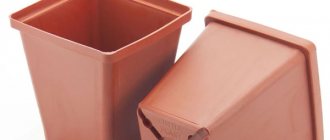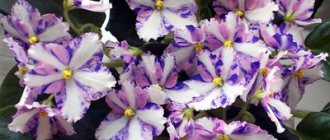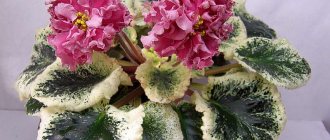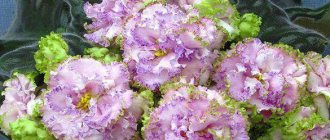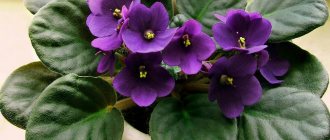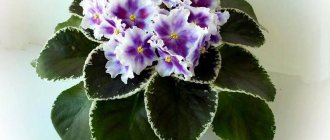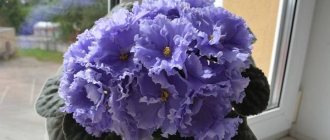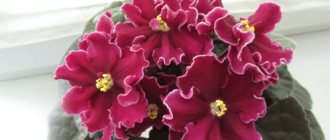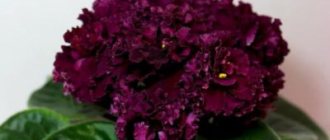Violet PIK-Byzantium (M. Pikalova)
Tomato Cornabel f1: description of the variety and cultivation characteristics
PIK-Byzantium belongs to the genus of hybrid Saintpaulias from the Gesneriev class. The variety was bred in 2010 by domestic breeder M. Pikalova, which is confirmed by the prefix “PIK” before the name.
The rosette is compact, but tends to lift up its leaves, forming a head of cabbage. The leaves are medium-sized, light green, round, quilted with a slight waviness along the edge. The cuttings are not very long, but thin and rather fragile.
The flowers are medium-sized and have an interesting wasp-like shape. The petals are narrow, have a dense texture and fringe.
The color is very interesting - marbled, consisting of shades of white, pink and crimson. Along the edge, the fringe differs in color unevenly, it is often interrupted and has a green or bronze color.
Attention! This exotic beauty has no known sports. But this does not mean that this cannot happen. It may also not be a sport, but simply an unusual flowering associated with the conditions of detention
It may also not be a sport, but simply an unusual flowering associated with the conditions of detention.
Violet Bohemia: description of the variety and characteristics
Violet goddess of beauty 19 photos description of Saintpaulia variety ek-goddess of beauty features of planting and care
Violet Bohemia: video
The wild form of Saintpaulia is native to East Africa and can be found in the forests of Tanzania and Rwanda. Violet Boheme is considered an evergreen, herbaceous, perennial plant with short stems. The foliage is hard, pubescent, and capable of forming rosettes. The shape and color of the foliage may vary. The flowers are large and collected in clusters. In the capsule fruits, a large number of small seeds ripen. Taking wild forms as a basis, it was possible to develop a number of varieties that have different shapes of flowers and inflorescences, differ in flowering time, different shapes, sizes and colors of foliage. Those varieties that were bred by breeders are often called hybrid Saintpaulias. Due to the fact that the varieties differ in color, shape of flowers and foliage, it has become possible to breed and then cross a large number of different varieties, so you can find a large number of plants that can be grown at home. Also, quite often, when growing violets, you can encounter sporting - manifestations of traits that are not characteristic of a particular variety. The form that was obtained in this way is called sport. For this reason, sport often becomes an impetus for work related to the development of a new variety. This phenomenon is not often found among varieties with a single color. Most often found among varieties that have complex selection, it is characterized by a combination of properties of a number of initial forms. The process of sporting is obtained through the inheritance of both dominant and recessive characteristics. The latter can happen quite rarely and acts as a surprise for gardeners. Russian breeders were able to develop a large number of varieties that are resistant. This is exactly the variety that Boheme is. Breeder Pikalova developed an original variety of the plant (PIK-Bohemia) with white-pink flowers, on which there are sparse lilac specks and a brown-green interrupted border on fringed foliage. The foliage of the PIK-Bohemia violet is dense, with virtually no fibers. The AB-Bohemia variety was bred by A.V. Tarasov became famous among flower growers in the second decade of the 21st century. Violet AB - Bohemia is distinguished by slightly pointed tips of the foliage and double, corrugated flowers, which are collected in dense inflorescences and form a cap during flowering. The petals have an unusual color - black and burgundy. There are varieties of AV-Bohemia sports, which differ from each other in the original color of the petals and the shape of the inflorescences. They can be found on sale under the name AV-Bohemia Sport.
Introduction
Violet Bohemia: photo
In many specialized gardening stores you can find attractive plants that are distinguished by dark green foliage, which will have fibers and beautiful flowers. They are often mistaken for violets, but in fact this plant is a Saintpaulia. Those who breed plants call it Uzambara violet. In fact, Saintpaulias do not belong to the violet family. Its discovery occurred purely by chance in the 90s of the 19th century. Saintpaulia was opened by the military commandant of the Uzambara district of the German colony in East Africa - Walter von Saintpaul. For this reason, the plant became the owner of its name - Saintpaulia. He sent seeds to Germany, which after some time showed the first shoots. Of course, anyone who has seen this plant will immediately note its similarity to violets, but this is only an external similarity. But many flower growers do not like to go into detail about what classification this or that plant belongs to, which is why this variety is called violets.
AV-Bohemia
Violet macho
violet AV-Bohemia from the Violetkeeper collection
Watch this video on YouTube
What does the AB violet variety look like, Your Grace, photo and description? Feeriya777 over a year ago tags: indoor plants, Saintpaulia, varieties of violets, Uzambara violet. Violet AV-Bohemia belongs to the Fialkovod selection.
Violet AV-Bohemia is not very easy to find; it always stands out from the blooming collection. Slightly pointed leaf tips are deep dark green. Dark red double flowers and abundant lush and early flowering. Beautiful flower shape.
Dark green, slightly wavy, pointed leaves. Violet AV-Bohemia (760-4). Flower: Double ruffled maroon pansy.
Rosette: Dark green, slightly wavy, pointed leaves. What does violet AB Lacy lilac look like, photo and description? Feeriya777 2 years ago tags: indoor plants, Saintpaulia, varieties of violets, violet, flowers.
From this article you will learn what conditions the PIK-Bohemia violet (M. Pikalova) imposes on its owner when grown at home, so that its flowering is full and long, and the rosette is healthy and. Violet "Bohemia": description and cultivation features. They are known to flower growers as Uzambara violet. On sale they are often called AV-Bohemia sport. Violet Bohemia, like any other, requires careful soil preparation before planting.
Unfortunately, even if a store-bought substrate states that it is suitable for Saintpaulia, this does not guarantee success. AB-Bohemia, like any violet, prefers light soil with sourness (can be determined using special indicator paper). It won't be difficult to create one. Violet AV-Bohemia sports.
Flower: Ghost. Terry wavy white stars with a crimson edge and a penciled black and red border. Rosette: Light green pointed leaves. After reading this article, you will learn what the chimera violet Olenka (EK and PT) looks like.
Description and photo, features of the chimeric violet variety Olenka, proper watering, fertilizing and lighting of the plant at home. Buy violet AV-Bohemia (Violetkovod). Order a violet. Terry corrugated dark burgundy pansies.
Dark green, slightly wavy, pointed leaves.
AV-Love (Violetflower)
Author: admin · Published 10/17/2018 · Updated 10/17/2018
Violet AV-Lubov (Violetkovod)
Clusters of double pink cherry blossoms with ruffled edges and a green border. Rosette: Serrated dark green with red underside. Standard (description of the Violet Guide).
Honestly, I don’t see the difference between this variety and the sport from LE-Rose of the Winds, except that the leaf is even. Although there is clearly a difference, this is the first impression of the variety.
My violet AB-Lubov turned out without a green border. Perhaps it was hot for her, and besides, this was her first flowering. But the “rose” shape of the flower is very interesting and blooms like a rose, gradually unfolding its petals.
It remained in this state of “budding” for more than 1 month and new flower stalks kept growing and growing. They open very slowly. In total, flowering lasted about 3 months.
The rosette turned out to be loose, but for now I attribute this fact to the youth of the violet. The first flowering was such that some flower stalks had to be removed. The AB-Lubov variety is, in my opinion, interesting. There is potential.
R. S. Violet grower about the AB-Lyubov variety: “Well, in general, as promised. In my variety, according to a simple scheme, you got a cap on a quite compact rosette of two rows of leaves, i.e. the scheme works not only for me"
Preparing violets for transplantation
- Water the plant 180 minutes before replanting so that it slips out of the container, but the soil does not stain the leaves.
- Clear the roots from the soil, cut off damaged and rotting ones (up to 80% of the roots can be removed painlessly for the plant).
- If rot is detected, treat with charcoal.
- If the roots are completely destroyed, the rosette is first rooted in water and then moved to the ground.
- Watering during the “move” is carried out with settled water, the temperature of which is several degrees higher than room temperature.
Violet “chic poppy”: features and care
While the violet is taking root, it must be covered to avoid rapid evaporation of moisture, but holes must be made for the passage of air. Watering is not carried out before rooting begins, so for the comfort of the plant, place a damp cloth around the pot or put moss in a tray.
Well, almost black violet Dark Night of The Soul
Home flower with red flowers When talking about almost black varieties, it is impossible to ignore the Dark Night of The Soul variety.
A beautiful, even, symmetrical rosette, semi-miniature in size, which forms independently. The leaves are variegated, rounded, and quite large. A special feature of the variety are spoon-shaped leaves, the edges curl slightly upward. The color of the leaves is variegated, medium green with white.
The flowers are wine-black, double pansies with a coral-red underside. In bud, the half-opened flower is almost black, but as it opens it acquires a red, rather beet-like, hue.
Important! This variety is the only one bred by McDonald outside the Mac's series
Short description:
Violet AV-Bohemia (Violetkovod selection):
Size: Standard Leaf: dark green, pointed at the edges, slightly wavy Flowers: burgundy-wine, double
Cap-shaped flowering of AV-Bohemia
become the owner of this beautiful flower in a few mouse clicks : find an online store where the plant is in stock and it will be sent to you by mail. Another option, also a budget one, is social networks, where connoisseurs of blooming beauty sell or exchange home plants.
Bohemia is sold as a leaf, as a child and as an adult plant. Prices range from 200 rubles for one leaf and up to 1200 rubles for an adult flower.
When the variety first appeared on the market, prices for planting material started from one and a half thousand rubles.
The most popular varieties of the AB series and their photos
Home orange flower name
Every collector has types that are the most popular. And the violet grower is no exception.
Polar bear
The flowers of this species are large and voluminous. They resemble balls in shape. The color of the petals is white, and the flowers themselves are densely double. The leaves are medium green, slightly wavy and quilted at the edges. Plant sizes are standard. It was withdrawn in 2022.
Bohemia
This indoor flower became available to Russian flower growers in 2015. The color of the flowers is similar to that of fragrant ripe cherries - it is burgundy-black. Dark green foxtails have sharp tips. This sorso blooms on all sides, the flowers form a dense ball resembling a hat.
We recommend watching a video about the violet variety “Bohemia”:
Kishmish
This variety of violet will allow you to grow large flowers, shaped like stars. The petals are dark crimson, their edges are white, corrugated. The rosette is compact and has medium green, toothed leaves that are slightly wavy. The variety was bred in 2015.
Coral Castle
The variety exhibits semi-double and double flowers. They look like pansies with a ruffled brown edge. Their color is coral-raspberry. The leaves are green, wavy and oval in shape. The bush sizes are standard.
Crimean Cherry
Pansies are distinguished by their corrugated petals. The flowers are double type and have a dark burgundy color. Leaves are dark green. They have an oval shape and a pointed tip. The leaves are slightly wavy. Standard sizes.
We recommend watching a video about the violet variety “Crimean Cherry”:
Terry Petunia
The flowers of this plant resemble roses with white petals, and along the edges there is a corrugated edging of dark cherry color. This is a small standard with a compact socket. It has medium green wavy leaves. The variety was released in 2022.
Mexican Jerboa
The branches are large, their color is ash-pink. They are shaped like stars. There is a dark crimson edging. The edges are wavy. The leaves are dark green, wavy. Compact size socket. The variety was released in 2022.
We recommend watching a video about the violet variety “Mexican Jerboa”:
Mimosa
Mimosa is a semi-double flower whose shape resembles stars. The flowers are semi-double, have a wide corrugated green edge and a crimson edging. The leaves are quilted, medium green. The variety is standard, was obtained in 2022.
Natasha Rostova
Flowers are double type, large in size. They have wavy edges. The shape of the flower resembles stars. The color of the petals is white, and they are framed by a crimson edging. The leaves are medium green and serrated. This variety was released in 2022
Plush
The stars are large, semi-double. Their color is purple-violet, and the edging is dark purple. The texture of the foliage is such that it visually and to the touch resembles plush. They are dark green in color, pointed at the edges and quilted. The variety is standard, released in 2022.
The Snow Queen
White stars of large size and semi-double type. They are distinguished by a corrugated purple edge and a fancy blue eye. The leaves are medium green, jagged and slightly wavy. The plant was bred in 2022.
Furor
It is distinguished by huge and semi-double stars. Their color is white and their edges are wavy. Fcussion prints are scattered across the petals. The leaves are quilted, toothed, and medium green in color.
Tango
The plant forms large double-type stars. The color of the petals is dark cherry. The rosette is medium green, flat. The leaves are green, wide, and have a slight velvety feel on the outer surface.
Gypsy Wedding
These are semi-double pansies, which are distinguished by a bright red spot located in the center of the flower. the edging is corrugated and green. The foliage is also wavy and dark green in color.
To ensure long-term flowering, it is important to regularly use complex mineral fertilizers
Mysterious forest
It is distinguished by huge and semi-double stars. Their color is white and their edges are wavy. Fcussion prints are scattered across the petals. The leaves are quilted, toothed, and medium green in color.
Bomb
This variety was released in 2022. Its flowers are huge and pink. They can be single or semi-double. They are shaped like bells. The edges of the petals are white. The rosette contains black and green quilted leaves. Plant sizes are standard.
Absolem
The variety was released in 2022. It is distinguished by large double white stars. They have wavy edges that are purple in color. The braid is wide and green. Present on the upper petals. Quilted medium green leaves form on the rosette.
We recommend watching a video about the Absolem violet variety:
VARIETIES AB
AV-Bohemia
Terry corrugated dark burgundy pansies. Dark green, slightly wavy, pointed leaves. Abundant flowering!
AV-Bohemian Rhapsody
Large double pink stars with a thickening of tone towards the edge of the petals. White braid and green ruffle. Dense petals, abundant flowering.
AB-Bolero
Large terry wavy white stars with red prints and a white pencil border. Serrated dark green leaves. 2022
AB Damask Rose
New 2022! Large hyperdouble lilac wavy stars with green edging of petals. Medium green, serrated, slightly wavy leaves.
AB-Dinosaur
Coral pink with an orange tint, semi-double and double stars with jagged edges and flecks of dark red fantasy, mostly at the edges. Slightly wavy, toothed, medium green leaves.
AV DiCaprio
Semi-double ruffled milky ultramarine stars with reddish undersides of the petals. Quilted, slightly toothed, medium green leaves.
AB-Crinoline
Large terry corrugated white stars with a dark lilac border. Serrated, wavy, light green leaves.
AV-Krasnaya Moscow
New 2022! Large double wavy red stars with a white edge. Medium green serrated leaves.
AV-Crimean Cherry
Very large double maroon stars with wavy edges. Olive green foliage with red underside.
AV-Kuraga
Large coral-raspberry ruffled semi-double pansies. Very unusual color! Dark green jagged, slightly wavy, pointed leaves.
AB-Frog
Semi-double ruffled blue and white pansies with blue edges and green upper petals. Toothed, slightly wavy, rounded leaves. Compact socket.
AV-Mexican Jerboa
Large wavy ash-pink stars with a dark crimson fantasy border along the edge of the petals. Wavy dark green leaves. Compact socket.
AV-Na Sweet
Large semi-double white wavy stars with a pastel pink eye and crimson fantasy along the edges of the petals. The option of flowering in pastel pink without white with raspberry fantasy around the edges is allowed. Quilted serrated leaves. Compact socket.
AV-Lake Fairy
Terry light lilac ruffled stars with purple braid and a purple mesh pattern on the petals. White pencil border. Medium green, wavy, quilted leaves.
AB-Panacotta
Huge white double flowers with wavy edges and a slight hint of pink from the center of the petals. The lower petals have a bright green ruffle. Panna cotta is a cream pudding, one of the exquisite Italian desserts. The rosette is dark green, slightly wavy foliage.
AV-Podmoskovnaya Rose
Double ruffled white flowers with a greenish-crimson edge and a crimson eye. Neat, slightly wavy rosette.
AV-Flight of the Valkyries
New 2022! Large single and semi-double beige-violet stars with lightening towards the center and a neon green wavy edge. Medium green, serrated, slightly wavy leaves. One of the breeder's favorite varieties!
AB-Midnight
Semi-double ultramarine ruffled stars with velvet texture. Dark green, toothed, slightly wavy leaves.
AV-Luxury
Huge terry coral pink slightly wavy stars with a wide fancy crimson border. Dark green serrated leaves.
AB-Pink Absolute
Large terry crimson and purple stars with a pencil white border. Super abundant flowering. A dark green, neat rosette with serrated leaves. Rose absolute is a dark red-brown rose petal oil with a sweet, luxurious rose floral scent.
AV-Sleeping Beauty
Large ruffled double white flowers with a pink border and pink rays from the center of the flower. Wavy serrated leaves.
AV-Warmth on the Soul
New 2022! Large single and semi-double crimson stars with a wide white edge and green ruffle. The raspberry tone is pink fantasy. Dark green serrated leaves.
AB-Hipster
Semi-double and double dark blue pansies with petal tips turned inward. Medium green, quilted, toothed leaves. Abundant and long flowering. 2022
AB-Black Prince
Very large black and red terry stars, dense texture. Dark green oval leaves with a red underside. Flowers remain fresh for a long time and do not fade.
AV-Ecstasy
Corrugated terry white and lime stars with a pink eye. Light green, slightly wavy leaves. Flowers last a long time. A huge fluffy cloud covers the entire rosette!
Flame of Kapsichore (Pechenkina/Totiev)
Semi-double bright red pansies with a lightened stripe in the center of the petal and a green ruffle, which is more pronounced on the ears of the two upper petals. Dark green wavy foliage. Chimeric sport from AV-Gypsy Wedding.
Violet "Bohemia" - description and cultivation features
We all know that violets are an integral part of the comfort of every home. They soothe with their delicate colors. There are actually a lot of varieties of violets, and there are also a lot of people who breed violets. And one of the most famous is the breeder Fialkovod.
Short description:
Violet AV-Bohemia (Violetkovod selection):
Size: Standard Leaf: dark green, pointed at the edges, slightly wavy Flowers: burgundy-wine, double
Cap-shaped flowering of AV-Bohemia
Bohemia is sold as a leaf, as a child and as an adult plant. Prices range from 200 rubles for one leaf and up to 1200 rubles for an adult flower.
When the variety first appeared on the market, prices for planting material started from one and a half thousand rubles.
Also bought with this variety:
Rebel's Restless Heart
RS-Snow in April
AB-Gypsy Wedding (744-21)
AB-Javan Moss (736-30)
AV-Ray of Light (746-80)
Bohemia is ready for landing
Before you bring home a leaf or baby of Violet AB-Bohemia, you need to prepare a high-quality substrate. Those who breed violets at home know that if the package says “for Saintpaulias or violets,” this is not a guarantee of successful planting.
Reminder! Setting the stage
- Mix one part of coarse river sand with three parts of peat and five parts of black soil.
- For the top layer, sphagnum moss, vermiculite and brick chips are suitable. Remember, the total mass of additives must be less than one of the main parts - river sand.
- Another popular composition for planting violets is a mixture where half of the sand is mixed, one part of coniferous soil, leaf soil, moss and two parts of turf.
- Pieces of clay pots or ordinary expanded clay will serve as drainage.
- Don’t forget to steam the soil and disinfect it with manganese. At the time of planting, the soil should remain loose and moist.
Preparing the substrate for planting
Where to plant
In order for a plant to feel comfortable, it needs favorable conditions. In the case of Bohemia it is:
- A darkened window or excluding direct sunlight: violet loves diffused light.
- The comfortable room temperature for violets is the same as for humans: not lower than 18, but not higher than 24 degrees Celsius.
- Permissible air humidity is 50 percent.
- Use soft water for irrigation, only a couple of degrees warmer than room temperature. Carefully monitor the moisture content of the substrate, as excessive moisture will destroy the plant.
- We fertilize the violet carefully even when the formation of buds begins. It is advisable to reduce the dose indicated on fertilizer packages by five times.
Polar bear
The flowers of this species are large and voluminous. They resemble balls in shape. The color of the petals is white, and the flowers themselves are densely double. The leaves are medium green, slightly wavy and quilted at the edges. Plant sizes are standard. It was released in 2015.
Bohemia
This indoor flower became available to Russian flower growers in 2015. The color of the flowers is similar to that of fragrant ripe cherries - it is burgundy-black. Dark green foxtails have sharp tips. This sorso blooms on all sides, the flowers form a dense ball resembling a hat.
We recommend watching a video about the violet variety “Bohemia”:
Kishmish
This variety of violet will allow you to grow large flowers, shaped like stars. The petals are dark crimson, their edges are white, corrugated. The rosette is compact and has medium green, toothed leaves that are slightly wavy. The variety was released in 2020.
Coral Castle
The variety exhibits semi-double and double flowers. They look like pansies with a ruffled brown edge. Their color is coral-raspberry. The leaves are green, wavy and oval in shape. The bush sizes are standard.
Crimean Cherry
Pansies are distinguished by their corrugated petals. The flowers are double type and have a dark burgundy color. Leaves are dark green. They have an oval shape and a pointed tip. The leaves are slightly wavy. Standard sizes.
What is needed for rooting
To root, place the “gold of the Nibelungs” violet leaf in clean water, having previously treated the cut with charcoal powder or potassium permanganate. After 15-20 days, roots form, which signals the possibility of planting in a soil mixture: sand, peat, perlite with a pH of 5.5-6.5. These are mandatory requirements that allow the plant to feel comfortable.
Violet PIK-Bohemia (M. Pikalova)
Bohemia, translated from the French boheme, means nothing more than gypsy.
Its interpretation is an eccentric lifestyle. It is typical for a certain part of the artistic intelligentsia. And also for those who have a similar lifestyle: theatrical and artistic circles and their environment.
Genus, family
- The Bohemia variety belongs to the Gesneriaceae family;
- Type: Saintpaulia. Sauntpoulia ionanta;
- Saintpaulia violetflower or Saintpaulia violetflower.
Origin story
Fringed green-white-pink flowers with intermittent green-brown ruffles and sparse lilac specks against a background of a bright green rosette. This is how the author presents his creation. Pikalova Marina Vladimirovna.
She was interested in flowers even in her youth:
- Roses;
- Hydrangeas;
- Clematis;
- Lilies;
- And before that there were palm trees, ferns, orchids.
It was not possible to grow violets. When Nance Leigh was seen at the exhibition, her new story began. With Saintpaulias.
She began to develop new varieties at a more mature age. It works better with semi-miniatures.
These are its most famous varieties:
Hawaiian rose;
Aurora;
Vanechka;
Poplar fluff.
Photo and description of the variety
Double star-shaped white flowers with numerous pink-lilac shades and splashes. The greenish border on the petals is not continuous. She breaks off. But on some petals it is absent;
- A neat semi-miniature rosette of bright green curved leaves with jagged edges. Short petioles allow the leaves not to open the middle of the rosette;
- Peduncles are short and strong. They confidently hold all the flowers above the rosette. No blockages.
When is an AV-Bohemia transplant needed?
Seasoned flower growers say that replanting for AV-Bohemia is not an emergency measure, but a mandatory annual procedure, which it is advisable to leave for spring or autumn.
At other times of the year, it is better not to start replanting, as the flower may not adapt to the new pot.
Important! The new transplant goes into a larger pot. If you do not plan to change the container, then you will have to partially cut off the roots of the violet - no more than 80%. If the flower has not had time to grow, then it is permissible to leave the old pot, however, be sure to clean and disinfect it
For a young plant, replanting takes place while preserving a small clod of soil, replacing the drainage and the rest of the soil. Compaction is carried out after two to three waterings
If the flower has not had time to grow, then it is permissible to leave the old pot, however, be sure to clean and disinfect it. For a young plant, replanting takes place while preserving a small clod of soil, replacing the drainage and the rest of the soil. Compaction is carried out after two to three waterings.
Reminder! A transplant is urgently needed if:
- the top layer is covered with a whitish coating
- fertilizing does not help revive fading leaves
- found many densely spaced roots
- the quarantine of the new flower is over
- young growth of a rosette emerges from a rooted leaf
If the plant is young, then it is permissible to transship it by increasing the size of the pot and adding fresh soil.
Increasing the size of the pot for violet AB
Features of violets of the “gold of the Nibelungs” variety
“These plants are no more capricious than other flowers grown on your windowsill,” says Elena Lebetskaya. By correctly determining the type of soil and deciding on the shape and size of the pot, you will save yourself from further problems that may arise when growing Saintpaulias. Not only this is important, but also the right choice of place for successfully growing the plant. In addition to annual replanting, it is recommended to carry out measures related to preventive treatment against diseases and pests twice a year.
The peculiarity of the formation of a lush, beautiful bush lies in the optional removal of leaves from the center of the rosette; the violet “LE Gold of the Nibelungs” itself perfectly assembles into a “bouquet”. If there are several rosettes in a pot, remove those that are unnecessary so that the plant can develop freely and form a bush.
When the flower stalks, for some reason, cannot rise above the leaves and form a beautiful rosette, this means that the violet is sick, and insect pests have become a possible provocateur of the invasion. In this case, treatment with plants using special substances - acaricides - is required.
Drought-resistant steppe plants with flowers
This chapter lists steppe flowers with names that do not tolerate stagnant moisture.
Adonis (ADONIS). Ranunculaceae family.
Adonis vernalis (A. vernalis) is an elegant spring plant of the steppes of Europe and Siberia. It is a perennial with a short rhizome and branched stems, forming a bush 20-30 cm high. The leaves are light green, thinly divided.
The flowers are single, bright yellow, up to 8 cm in diameter, shiny and very elegant. Adonis blooms in early spring (late April - early May).
Growing conditions. Sunny areas with rich, loose, alkaline soils, well drained. This drought-resistant steppe plant with flowers does not tolerate stagnant water.
Reproduction. Preferably by seeds, as it does not tolerate dividing the bush well. The seeds do not germinate quickly throughout the year. Sow freshly harvested. Planting density - 5-6 bushes per 1 m2.
Adonis is a difficult plant to cultivate and is a subject for experienced hobbyists. But if planted correctly, it can decorate a flower garden for 10-15 years without replanting.
Anaphalis. Family Asteraceae (Asteraceae).
Two species of this drought-resistant steppe plant growing in East Asia and North America are cultivated. A bush with erect stems 50-80 cm high, with white-tomentose pubescence on stems, leaves and flowers. The leaves are narrow, linear, entire. At the ends of the shoots there are small silvery baskets in a corymbose inflorescence. Easily self-seeding.
Types and varieties:
Anaphalis three-veined (A. triplinervis) - with larger leaves.
Pearl anafalis (A. margaritacea) - leaves are smaller.
Growing conditions. Sunny areas with dry neutral soils.
Reproduction. By dividing the bush (spring, late summer), by seeds (sowing before winter). Transplantation and division after 3-4 years. Planting density -9 pcs. per 1 m2.
Used in mixed flower beds, mixborders, and rockeries.
Goniolimon (GONIOLIMON). Lead family.
Steppe and semi-desert perennials, typical “tumbleweeds”, forming a dense spherical bush 10-40 cm high from highly branched inflorescences and oblong ovate leaves collected in a ground rosette.
Look at the photo: these steppe flowers, which are silvery “balls,” can decorate any flower garden on dry soil and a winter bouquet.
Types and varieties:
Beautiful goniolimon (G. speciosum) - rosette leaves are round, bluish, the inflorescence is in the shape of an “antler”.
Tatarian goniolimon (G. tataricum) - leaves are ovoid, pointed, the inflorescence is looser, corymbose.
Growing conditions. Sunny areas with deep, well-drained soils with added sand. They do not tolerate stagnant moisture. Salinity resistant.
Reproduction. Preferably by seeds, seedlings bloom in the 2-3rd year, it is better to replant young plants. Cuttings are possible in the spring. Planting density is single.
An excellent plant for rockeries or as tapeworms on dry slopes, against the background of an inert layer (crushed stone or gravel). They are also used in arrangements, especially in winter bouquets.
Growing Bohemia grapes
Bohemia table grapes belong to the crops of Ukrainian selection. This is a hybrid that was created by crossing the Millennium and Ordinary Malva varieties. It preserves the virtues of each ancestor, which is why it is so popular.
Growing Bohemia grapes
Variety parameters
The Bohemia grape variety belongs to the early varieties. It begins to ripen in early August. Active fruiting is observed 2 years after planting. According to the description, the growing season lasts only 110 days from the moment of flowering.
Description of the bush
The bushes are characterized by small growth, only 2-2.5 m. The flowers are bisexual, which significantly increases productivity.
The leaves are oval and consist of 5 lobes. On the outside there are small stripes of white color, and on the inside there is a slight waxy coating and rough areas. The color of the leaf blade is dark green. The vine is powerful and dense. The flowers are white. The tendrils are often located on the shoots.
Main signs of the fetus
Bunches of Boheme grapes reach a weight of 600 g. They are cylindrical in shape, with wide areas at the base. Medium sized berries. Their length is only 2 cm, and their weight is 20 g. The peel is dense and opaque. There is a slight waxy coating on its surface.
The fruits are sweet, although after 2-3 years ascorbic acid begins to appear in their composition, adding piquancy to the taste. The aroma is nutmeg, pleasant.
Recommendations for cultivation
The Bohemia grape variety is capable of bearing fruit, regardless of light conditions. Planting is allowed both in sunny and shaded areas. It is preferable to stick to planting in illuminated areas of the garden, as this speeds up the process of fruit ripening.
The soil should be nutritious (chernozem or loamy soil), with a low acid-base level. If the acidity concentration is high, liming is carried out. For 1 sq. m add up to 3 kg of lime, distributing it evenly throughout the area.
When choosing a seedling, take into account the following features:
- the height of planting material must be at least 1 m;
- the root system must be developed and have a length of 20-25 cm;
- near the root neck there should be a trace of the vaccination, which is done to strengthen the immune system;
- There should be no damaged areas or signs of parasites throughout the entire area of the seedling.
Prepare the planting hole in advance. Its depth is 60 cm and width is 80 cm. It is better to dig it up in early October. 10 kg of crushed stone and 4 kg of humus or peat are poured inside. Over the winter, all nutrients will be absorbed into the soil, thereby increasing the nutritional value of the soil.
The quality of watering is important for the plant.
A drainage system is needed to protect the roots from rot, since excess moisture, combined with sunlight, negatively affects the condition of the bush: the growth and fruiting of the crop slows down.
A small hill is made on top of the drainage system, into which the seedling is planted. The roots are leveled over the entire surface of the hole and carefully covered with the top fertile layer of soil.
Nearby, at a distance of 5 cm from the hole, a metal rod is buried, which acts as a support for the bush. The distance between bushes should be 3 m, and the space between rows should be about 4 cm.
Culture care procedure
Caring for Bohemia grapes is simple. The quality of watering is important. It is carried out when there is no scorching sun, otherwise it leads to root rot and complete destruction of the entire bush. Each plant requires 25 liters of warm water. The irrigation interval is 15 days.
The future harvest also depends on the quality of fertilizing. The first application of fertilizers is carried out 3 years after planting. In the spring, 2 kg of humus is added under the roots to saturate the soil with nutrients. In early July, the plant is saturated with a solution of potassium nitrate (30 g per 5 liters of water) to speed up the growth process. 15 days before the expected harvest, add a solution of ammonium nitrate (60 g per 5 liters of water). This improves the quality of the harvest. In the fall, in mid-October, a mixture of organic matter and mineral components is added to the root. 2 kg of humus and 50 mg of superphosphate are poured under each bush.
Pruning is carried out in the summer, after flowering. Remove all shoots that have strayed from the general structure of the bush. Most of them are removed, leaving only 5-8 eyes on each. Dry, diseased areas, which absorb all the nutrients and prevent the plant from developing, are also removed.
Pest and disease control
The Boheme grape variety is resistant to most diseases. It is only affected by powdery mildew, olive blight and fruit rot.
A solution of Bordeaux mixture (3 g per 5 liters of water) helps get rid of powdery mildew. You can permanently destroy olive spot with a solution of copper sulfate (30 g per 7 liters of water). Onion peel tincture helps against fruit rot (200 g infused in 5 liters of water for 24 hours).
Pests include fleas and ticks. Flea fleas are combated with a manganese solution, which is prepared in a ratio of 3 g of the drug per 3 liters of water. An effective remedy against ticks is considered to be tincture of cayenne pepper (30 g per 10 liters of water). Treatment against pests and diseases is carried out at intervals of 15 days until the crop is completely cured.
Choosing a pot
No matter how you feel about plastic, it is the best material for violets when it comes to flower pots. The fact is that the evaporation of water in such containers does not occur so quickly, therefore, the frequency of watering is reduced and the life of the plant increases.
Plastic pot for violets
Clay pots can destroy the plant. An SOS signal for the gardener will be fading leaves or traces reminiscent of the visit of small insects. The reason is the contact of clay and leaves. It is not necessary to replant the flower, save it, and at the same time decorate it, you can use raffia, sisal or coconut fiber.
As for the size, we select the diameter of the pot to be three to three and a half times smaller than the violet. You should not immediately take a large pot, the flower will not be able to master the huge earthen lump.
Young rosettes are initially placed in pots no larger than 5 centimeters in diameter, increasing in size after about six months.
Attention! The violet will not bloom until it fills everything with roots, so there is no need to rush here.
What does a Humaco Inches violet look like?
Humako Inches violet is the most common among indoor plant lovers. This is due to its extraordinary beauty: the combination of snow-white edges of the petals with a blue-violet core stands out brightly against the background of light green leaves. The rosette of leaves looks neat and compact, framing multiple flower stalks.
Amazing color of the Humaco Inches variety
Due to the small fibers located on all the leaves of the plant, as well as the velvety surface of the petals, the violet is covered with many sparkling reflections of the sun. This effect makes the flower even more decorative.
For your information! Violet variety Humaco belongs to the Gesneriev family. This is a hybrid variety developed by the Dutch floriculture company Humako. The company name appears in the name of each of their plants. But the word “inches” is translated as “inches,” which is an indication of the size of the varietal violet.
In nature, plants of this family can reach a height of 30 cm, but indoor varieties are much smaller in size.
About the history of appearance
The violet was first found in the mountains of East Africa, so the variety is often called Uzambara after the name of the mountains.
The scientific name of the violet genus is Saintpaulia. The word comes from the German language, derived from the name of Baron Saint-Paul, who first found the most beautiful flower. His breeder friend immediately bred the first domestic Saintpaulia, which in just a few decades won the love of flower growers all over the planet and became the ancestor of modern varieties of violets.
The color gradient may vary between specimens
Note! Violets were not named that way because of their purple color. The name of the flower comes from the word “viola” - that’s what it’s called in Latin.
In Polish, this word was modified to “fialek”, from there it passed into Russian as “violet” and became the basis for the name of the color.
What Saintpaulia Humako inches looks like
Gerbera: description and features of growing at home
Before you decide to purchase this variety of Saintpaulia and start growing it, it would not hurt to know the history of the origin of this flower and the features of its appearance.
Beautiful Humako inches
Description
This species is distinguished by the large size of both leaves and flowers. The leaves have a rich green color and pubescence, characteristic of all representatives of this species.
The flowers of this Saintpaulia are especially decorative. They have a rich inner blue color that smoothly turns into a snow-white edge. The flowers are the same size, the diameter of each is 6-8 cm. During flowering, the leaves are practically invisible under the cap of lush inflorescences.
Species affiliation
Saintpaulia belongs to the Gesneriev family. The flower was first discovered in the Uzambara Mountains of East Africa, which is why it is called the Uzambara violet.
In natural growth conditions, the plant is evergreen. The height of the rosette can reach 30-40 cm, which significantly exceeds the size of indoor specimens.
Origin story
The name Saintpaulia was given in honor of the commandant of the Uzambara district of Saint-Paul Illaire, who discovered them in 1893. It was he who first discovered this plant and collected the seeds. Subsequently, the seed material was transferred to the botanist from Germany Herman Wendland, and he gave the flower a name and determined that it belonged to the Gesneriev family.
For reference! The Humako inches variety is the result of breeding work by the Dutch company Humako, which specializes in developing new varieties of Saintpaulia.
Such highly decorative varieties as Humako flame and Humako violet are also the merit of this company. It is worth mentioning the Humaco Isabella variety, whose flowers have simply incredible colors.
Growing rules
In nature, Saintpaulias grow in tropical rainforests. The soil there is quite light, rich in humus, but by no means waterlogged. Violet grows most often in elevated, and therefore relatively dry, areas. Purchasing special ready-made soil will not always be a reliable guarantee that your violet will like it. However, flower growers have long developed a recipe for preparing a soil mixture that is completely suitable for African violet.
- It is necessary to prepare the ingredients, it is better to do this in the summer. You will need fine river sand, peat and garden soil rich in humus (ideally black soil).
- The steamed ingredients must be thoroughly mixed in a ratio of 1X3X5.
- It is advisable to fill the bottom part of the pot with expanded clay.
- The top layer can be sprinkled with brick chips.
- Planting is carried out in moderately moist crumbly soil.
It is better to place the pot with violet so that direct sunlight does not fall on it. In its homeland in East Africa, it grows under the canopy of a multi-layered tropical forest, sunlight reaching its leaves many times dispersed by the tree crowns. In terms of air temperature, the violet is an excellent pet; it is quite comfortable at the same temperature as a person (from 18 to 22°).
A healthy plant needs to be watered 1-2 times a week, preferably in the morning. Under no circumstances should the soil be over-moistened: excessive moisture is detrimental to this plant. The rotting process can be very difficult to stop. Often it is excessive watering that causes the death of violets. She is also very picky about fertilizers. They must be applied at the beginning of flowering, reducing the dose indicated in the instructions by half.
Plastic pots are great for violets: they retain moisture better, which allows you to water the plant less often. The size of the pot is also a very important factor in determining the health of Saintpaulia. Often its flowering is delayed because there is too much soil in the pot. The violet blooms when its roots fill the entire volume of the pot.
However, replanting is necessary and even necessary, so it is better to do it in the off-season: in spring or autumn. If you replant it in the same pot, you will have to reduce the number of roots. To preserve the root system, you need to choose a slightly larger pot and be prepared for the fact that the violet will not bloom for some time. The drainage of the pot must also be replaced: unwanted microorganisms may begin to develop in the old one. Repotting into a smaller pot can encourage flowering.
Modern varieties of violets are most often propagated using leaves. Saintpaulia has a wonderful feature: it can form young plants at the leaf cut.
In the next video you can take a closer look at the “Bohemia” violet variety.
Unanswered messages | Active topics
List of forums » Violet House » Exhibitions in the Violet House
Current time: Thu Apr 04, 2022 16:33
List of forums » Violet House » Exhibitions in the Violet House
Current time: Thu Apr 04, 2022 16:33
Violet "Bohemia": how to plant and care
Description of AV-Bohemia
This variety appeared thanks to Russian selection - Fialkovod. It became available for planting in 2015.
Finding this violet is not so easy, but this Saintpaulia will stand out from any flower collection. The leaves have pointed ends and are a rich dark green color. The flowers are pleasant double pansies, which are often compared to cherry trees for their burgundy-black tones.
The rosette has a neat shape; there can be about five buds on a bush, which increase significantly as they grow.
AB-Bohemia blooms all around, creating a beautiful dense ball of flowers that last a long time and the plant becomes lighter in weight after dropping the peduncle.
You can get Saintpaulia through online stores, ordering the plant by mail or on social networks in special groups for the sale of seeds and flowers. Boheme is more difficult to find in regular gardening stores. The price for a whole adult plant can reach up to a thousand rubles.
Landing
Violet Bohemia, like any other, requires careful soil preparation before planting. Unfortunately, even if a store-bought substrate states that it is suitable for Saintpaulia, this does not guarantee a successful result.
A small note on landing:
- River sand and peat are mixed in a ratio of 1 to 3 with black soil.
- The top layer is laid out from brick chips, but any additives should be in smaller quantities than river sand.
- You can add pine needles and moss, and use clay fragments or expanded clay as drainage.
- The soil must be disinfected with manganese.
- It is necessary to ensure that at the time of planting the soil is loose and slightly moist.
Conditions
